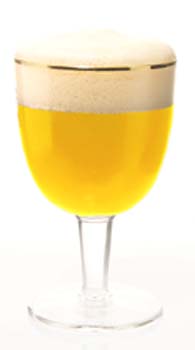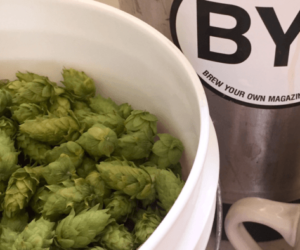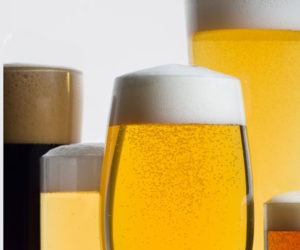Techniques for Getting Good Beer Foam
Beer foam can be a mystery. Usually, it just resides on top of our beers without us having made any special effort for it to appear. Other times, it can mysteriously disappear and nothing seems to remedy the situation. In this article, I’ll discuss what is known about beer foam and offer suggestions to homebrewers who wish to improve their foam.
What’s in beer foam?
Brewing scientists have studied foam for decades, using a variety of techniques. They have sought to answer the questions, “What is beer foam?,” “How can it be improved?” and “Is there a silver bullet hat makes or breaks the foaming potential of beer?” In one study, brewing scientists gathered foam to study using the following method:
The scientists put beer in glass cylinders and blew nitrogen bubbles through the beer to create beer foam. This foam was then collected and dissolved in a beer and water mixture and generated again by blowing more bubbles through it.
This foam was then gathered and separated into two fractions by a technique called gel filtration. One fraction contained high molecular weight molecules, the other contained low molecular weight molecules.
When scientists examined the high molecular weight fraction, they found it to be mostly carbohydrate. About 10% of this fraction was protein; the most common was a protein called protein Z. Protein Z is an albumin with a molecular weight of 40,000 Daltons. (Albumin is simply a name for any protein that is soluble in water and coaguable by heat. A “Dalton” is basically a measure of the size of a protein (or other molecule).)
Beer scientists found that the low molecular weight fraction of beer foam was mostly protein, in particular a 9,700 Dalton protein from barley called Lipid Transport Protein 1 (or LTP1). The fraction also had smaller amounts of the proteins hordein and glutelin. (In the brewing literature, protein Z and LTP1 are alternately referred to as proteins or polypeptides, reflecting the fact that native proteins undergo proteolysis (protein breakdown) during malting.)
Once the scientists had isolated the two fractions of foam, they then took these fractions and tried to recreate beer foam from them. This worked well and — in recreating the beer foam from its constituent parts — they learned two interesting things. The low molecular weight fraction (the fraction containing LTP1) were good at forming foam while the high molecular weight fraction (containing protein Z) helped stabilize the foam.
They also tried making foam using only LTP1 (from the low molecular weight fraction). In fact, they used two kinds of LTP1 — LTP1 isolated from beer foam and LTP1 isolated directly from unmalted barley.
The foam formed from beer-foam-isolated LTP1 was not as stable as foam from the entire low molecular weight fraction. And interestingly, the beer foam formed from LTP1 extracted from unmalted barley was very unstable. The inference here was that something in the malting or brewing process alters LTP1 to make it more able to generate foam.
Later it was determined that LTP1 is folded into a roundish globule in barley. In boiling wort, LTP1 unravels (denatures, in the lingo) and changes shape. So, boiling wort converts LTP1 from a mostly inactive form to a form capable of forming good beer foam.
Eureka?
At this point, you may be wondering, “where’s the mystery? Can’t I just add LTP1 and protein Z to my beer and get good foam?” Given the results, this is very logical and beer scientists have indeed focused on these proteins in creating and enhancing foam.
Studies have shown that LTP1 concentrations vary in barley depending on weather conditions during the growing season. Specifically, drier growing conditions result in higher LTP1 levels. If LTP1 extracts could be harvested from barley in dry years, these could be used to enhance beer foam. In a somewhat more interesting approach, a German team has introduced the LTP1 gene into yeast cells, to try to get brewer’s yeast to produce the protein.
Currently, if your beer doesn’t have a head on it, you can’t pop into your local homebrew shop and pick up a vial of LTP1 or protein Z. But, the conventional homebrewing wisdom has been to do the next best thing — add something to your recipe that contains a lot of protein.
Add wheat malt?
The “something” that is usually recommended as a cure for headless beers is wheat malt. The recommended amount is usually around 0.5 lb. (0.23 kg) per 5 gallons (19 L) of beer.
This recommendation is logical. Wheat malt contains more protein than barley malt, and by inference it should have more LTP1 and protein Z. In addition, observational evidence suggests that it works — wheat beers typically have huge heads. The one and only problem I find with the suggestion of adding wheat malt is that I’ve never seen it work.
My experience has been that, if you are having problems with forming a head, adding wheat malt doesn’t help. (On the other hand, if you are already getting decent foam, adding wheat can increase the amount and longevity of foam.) I’ve also noticed that many “low protein” beers form perfectly nice heads, counter to the idea that you need a lot of protein in your grain bill to form good beer foam.
One case in point is the Belgian beer Duvel (“devil”). Duvel is made from Pilsner malts and quite a bit of protein-less adjunct (sugar), yet it still forms a huge, rocky head that clings to the glass right to the end of the beer. (On the other hand, it’s big beer, so — even with the adjunct — there is a decent amount of Pilsner malt in the grist.) My experience with other “low-protein” beers also suggests that you do not need a lot of protein in your beer to form a good head. If you’re functionally foamless, I think you need to look to other avenues to generate beer foam.
Help for the headless
My suggestion for “headless homebrewers” is that there is one likely culprit for most headless homebrew — bad fermentations.
I think that most headless homebrews result from beers with too many “head killers” in them. Specifically, I’m thinking of some of the foam killing molecules — such as higher alcohols (or “fusel oils”) — that result from fermentation temperatures that are too high or worts that are underpitched. In most cases, I believe there are enough foam positive elements in the beer, but these are negated by fermentation byproducts that kill foam. (Note that Belgian yeasts and German wheat yeasts both reputedly produce lower levels of fusel oils than normal brewers yeast strains, especially at higher fermentation temperatures.)
In addition, when yeast are stressed during fermentation, they secrete proteases in larger amounts than unstressed yeast do. Stress may result from underpitching, underaeration or high-gravity fermentation. The resulting protease activity may decrease the amount of beer foam in the resulting beer.
Nobody said there would be a test
If you have little or no foam in your homebrew, a simple test should tell you whether you are lacking “foam makers” or have an excess of “foam breakers.” While sipping on a Duvel, vigorously shake your headless brew, then pour the beer into a tall, thin glass.
If no head forms, you don’t have enough foam positive molecules in your beer. In this case, more protein in the grist may be called for. (A more vigorous boil may also help if your boils are weak.)
If foam forms, but quickly dissipates, you have all the protein you need, but other factors are interfering with them. My suggestion in this case would be to make a yeast starter each time you brew, aerate well and control the fermentation temperature of your wort as it ferments.
Note that your beer needs to be carbonated for this test to work. If it’s flat, try raising bubbles by another method, such as with an aeration stone.
Other factors
Foam is influenced by numerous other factors. Dirty glasses, for example, kill beer foam. Fat kills foam by occupying space on the surface of the beer where foam would form.
In contrast, higher levels of carbonation build foam. Bubbles in beer grab proteins (and other molecules) and drag them to the surface.
Glasses that are etched on the bottom, as Duvel glasses are, also enhance beer foam. The etching provides nucleation sites for bubbles to form and the continuing stream of bubbles builds foam that at least partially compensates for foam collapse.
Smaller bubbles also raise more beer foam, and nitrogen forms smaller bubbles in beer than carbon dioxide does. This partially explains the foam on stouts served from nitrogen taps.
Lastly, homebrewers who keg their beer should be aware that foam positive molecules can get “used up” when foam is created. Thus, if you shake your keg to carbonate it, you may be dipping into your pool of foam makers for your beer.
Some commercial brewers use a silicone anti-foam during fermentation to limit foaming during fermentation. This allows them to fill their tanks higher, but also minimizes “wasted” beer foam produced during fermentation. The silicone is later removed via filtration. (Note that beer foam and yeast kraeusen are not the same thing.)
Good foam seems to follow good general brewing practices. There is no silver bullet to getting good foam, so focus on making good beer and the foam should come naturally.



